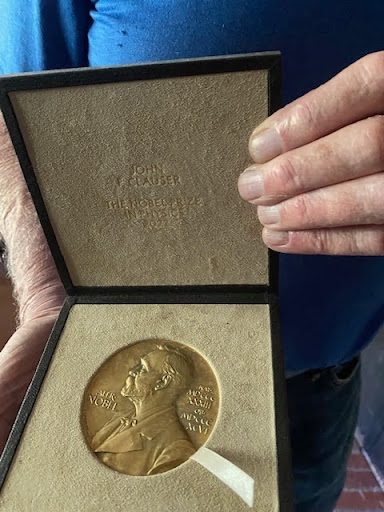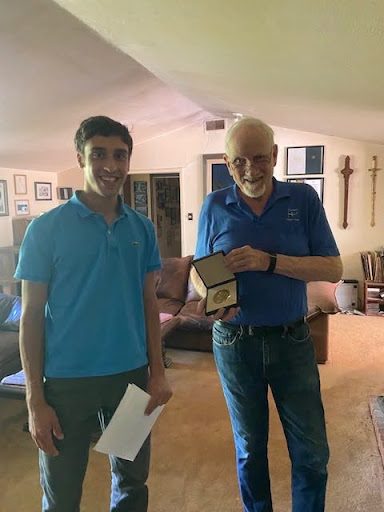It is not every day that someone is invited to the home of a Nobel Prize winning physicist. Dr. John Clauser, recipient of the 2022 Nobel Prize in Physics and the 2010 Wolf Prize, lives just a few minutes away from my home in Walnut Creek, California, and he had agreed to meet with me for an interview. As someone passionate about science and research, I looked forward to asking him about his career and learning from his experiences.
To prepare, I read several of his research papers and watched interviews he had given over the years. His work was not only complex from a scientific standpoint but also touched on deeper questions about the nature of reality and the strange ways particles seem to interact across space. There was something almost philosophical about it, and even a little magical. The idea that two distant particles could remain connected regardless of the distance between them was hard to wrap my head around. With all of this in mind, I wanted to ask thoughtful questions and gain a clearer understanding of the science behind the work that had earned him the Nobel Prize.
Dr. Clauser invited me to his home for the interview. As I drove through the neighborhood, a quiet and familiar area I had visited many times before, I could not have guessed that a Nobel laureate lived there. When I arrived, he opened the door with a warm smile and said, “You must be Diego. Come on in.” That smile stayed with him throughout our conversation. He spoke with energy and enthusiasm, often laughing as he recalled key moments from his career.
The home of a Nobel Prize winner is just as you might expect it, yet not at all. When I walked in, I noticed there was not much light inside, and classical music was playing softly in the background, as if reinforcing the familiar image of a genius at work. That first impression drew my attention to everything else in the room. The bookcases were filled with physics texts and volumes of The Physical Review. Nearby, sailboat trophies were arranged on side tables and tucked into corners of the room. Newspapers and handwritten notes covered his desk, giving the space the feeling of a place still very much in use. It was clear that even in retirement, physics remained central to his life.
We sat in his living room to talk. As we began our conversation, he looked at me and asked, “Would you like to see the Nobel Prize?” Was that even a question? I said yes enthusiastically.
He stood up and returned with a small wooden box, which he opened to reveal the medal. It was heavier than I expected, with a bright gold surface and finely detailed engravings. The Nobel Prize is something many scientists aspire to, but for Dr. Clauser, it seemed to carry a deeper, more personal meaning. As he held it in his hands, he looked at it with a sense of pride that was thoughtful and sincere rather than boastful. Nearly fifty years had passed since his groundbreaking work, and some of the colleagues who had been part of that journey were no longer here to see this moment. The prize felt less like an award and more like a tribute.

After looking at the medal, I asked if he could describe the experiment that had led to the award. He smiled and said, “How much time do you have?” Then he began describing his work with Stuart Freedman at the University of California, Berkeley in the early 1970s. At the time, Clauser was a postdoctoral researcher and Freedman was a graduate student. Together, they carried out the first experimental test of Bell’s inequality using pairs of entangled photons.
Bell’s inequality is a mathematical rule that sets limits on how particles should behave if their properties are well defined and nothing can travel faster than the speed of light. These ideas form the basis of what are called local hidden variable theories. Quantum mechanics makes a different prediction. It states that when two particles are entangled, the property of one is instantly linked to the property of the other, so measuring one tells you the state of the other, no matter how far apart they are. When these measurements go beyond the limits set by Bell’s inequality, they indicate that the world does not always follow the rules of local hidden variables.
To test this, Clauser and Freedman created a setup where pairs of entangled photons were emitted and sent in opposite directions toward detectors. The detectors measured the polarization of the photons at various angles. According to classical theories, the results should not exceed certain statistical limits. But they did. The experiment showed a clear violation of Bell’s inequality, in agreement with the predictions of quantum mechanics. It provided strong evidence against local hidden variables and in favor of nonlocal effects.
Despite the importance of the result, many physicists at the time dismissed the entire effort.
“I was told repeatedly that I was wasting my career,” he said. “Even Richard Feynman thought it was a silly question. He said I was wasting valuable resources and should do some real physics.” Clauser ignored the criticism and continued anyway.
“Quantum mechanics was a subject that many people failed to understand, though few were willing to say so. I was one of the few who admitted it and made an effort to truly understand it.”
He published the results of his experiment in 1972, even though the work did not receive much attention at the time.
After Berkeley, Clauser joined Lawrence Livermore National Laboratory, where he worked on X-ray laser interferometry, a technology that can be used to improve medical imaging of soft tissue.
With the help of private grants, he built a laboratory in his own home and continued his research in that area. He later gave me a tour of it. The space was filled with scientific instruments and machines, including machines from World War Two and devices he had built himself. His lab was a place where he could tinker freely and explore ideas on his own terms, without pressure or judgment from others.
Recognition did not come quickly. It was not until forty years after he had carried out his groundbreaking experiment that Dr. Clauser received his first major honor, the Wolf Prize in physics. Ten years later, he shared the Nobel Prize with Alain Aspect and Anton Zeilinger for their foundational work on quantum entanglement.
Reflecting on how the scientific community has changed, he said, “Now everybody talks about entanglement,” with a smile. “But back then, almost no one thought it was worth looking at.”

His story is a reminder that in science, progress and recognition can take time, but persistence and belief in one’s work can make all the difference.
For Dr. Clauser, that sense of belief is grounded not in religion, but in science and the natural world. As an atheist, he spoke about how physics offered a kind of clarity and consistency he felt was often missing in religion. “In church,” he told me, “depending on which church you go to, you might get a different answer if you ask the same question. But not in physics. In physics, if you ask the same question, you get the same answer. That is why I love it.”
As our conversation came to a close, Dr. Clauser offered a few final thoughts for high school students interested in science and research. “Try to understand everything as deeply as you can. Be honest with yourself. If you do not know something, admit it. Then go and find out,” he said. “One good experiment is worth one thousand mediocre theories.”

